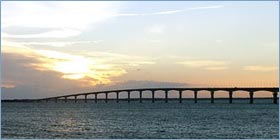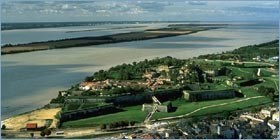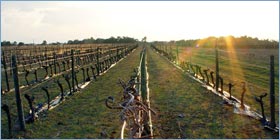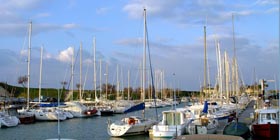The Poitou Charentes region is made of 4 "départements": the Vienne, the Deux-Sèvres, the Charente, the Charente-Maritime.
The region is almost completely unspoilt with virtually no industry and is one of the most tranquil in France. It lies on the west coast of France between the rivers Loire and Gironde, spreading inland from the Atlantic at La Rochelle to just north of Poitiers.
Its long Atlantic coastline is noted for long sandy beaches, marinas, golf courses, and islands. Two popular large islands, the Ile de Ré and the Ile d'Oléron have been joined by bridges to the mainland.
Founded by the Romans, the historic city of Poitiers in the North of the region is situated on a rocky plateau above two rivers. It is a pleasant, lively university town and a good base from which to explore the Vienne. Futuroscope, near Poitiers, is a vast science and technology park, which has an impressive variety of audio-visual, interactive and virtual reality experiences.
The landscape of the Charente is generally speaking flat, wooded, agricultural land until you reach the hills of the Vendée. Angoulême is the main town and a busy centre with good shopping. It has an interesting old quarter and 75 restaurants. Worth visiting nearby is La Rochefoucauld: the château is reminiscent of the Châteaux of the Loire and the Italianate Grand Courtyard there is one of the finest in France. A few kilometres away, Lusignan has an ancient ruined castle said to have been built by fairy Mélusine.
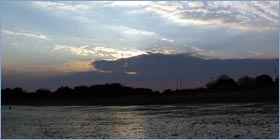
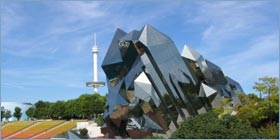
Angoulême lies at the head of the navigable part the River Charente, which flows along a wide valley from there, through Cognac, to the old Roman town of Saintes. Situated on the left bank of the river, Saintes has many fine mediaeval and 18th and 19th century buildings and was the birthplace of Dr. J.I. Guillotin, the inventor of the guillotine. La Rochecourbon, North West of Saintes is a 15th century castle, which was restored by novelist Pierre Loti in the 1920's and has some stunning gardens.
From Saintes, the river flows to its mouth just below Rochefort-sur-Mer. This is the Charente-Maritime, an area of marshland that runs along the coast known as the Marais and famous for its oyster beds. Delightful Marais Poitevin, with its labyrinth of waterways is best explored by boat. Royan is a relatively modern town and seaside resort with good beaches.
The busy historic port of La Rochelle caters for both huge ocean-going commercial ships and a large fishing community. Despite this industrial presence, the town, with its old harbour defences, arcaded houses and parks, has preserved much of its character and is a popular holiday centre. There is good shopping, an excellent fish market near the Old Harbour and numerous bistros. La Rochelle is the access point for Ile de Ré, a beautiful island just off the coast of La Rochelle that has managed to keep much of its authentic character. It is dotted with nature reserves where multitudes of wild birds and animals live, protected from the advance of technology and mankind.
The island is famous for its salt, which is collected by salters towards the western end of the island, its oysters and its potatoes, all of which you can enjoy in the many restaurants scattered throughout the island’s villages. The Atlantic Ocean is much less dangerous here than in other areas of the mainland coast so bathing is recommended for all.
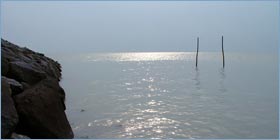
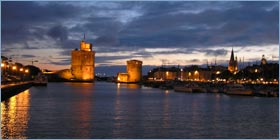
Charente Maritime is a district on the western shore of the Atlantic. This is a popular summer resort for bathers and sun-worshippers with endless beaches and thundering waves. This is an area with many navigable waterways and wonderful ports.
La Rochelle has been a commercial centre and a busy port since the 11th century. It is surrounded by stately buildings, and the harbour is the biggest yachting centre for France's Atlantic coast. Inland fromc La Rochelle, there is lush countryside filled with medieval architecture along the Pilgrim's route to Spain's Santiago de Compostela. Wine chateaux large and small clearly mark the wine regions that offer a selection of wines from both Bordeaux and the Loire.
CLIMATE
The region that extends from the South of the Vendee to the estuary of the Gironde, occupies a unique position on the Atlantic coast of continental Europe, between the 45th and 46th parallels. This situation ensures a mild and sunny climate. The period of sunshine (2,600 hours a year) is comparable to that of the Côte d’Azur with an early spring and a long dry summer and temperatures often reaching 30°C. or more. The influence of the Gulf Stream produces winters as mild as those of the Mediterranean. Rain, in winter and spring takes the form of a steady drizzle, although it seldom rains all day. The peak of the tourist season is in July and August but due to the special climate during the rest of the year, it is particularly good for relaxing visits of discovery and exploration.
FOOD
This is the home of the world's finest brandies, green-hulled oysters and the creamiest butter in France. The combination of fresh oysters, spicy sausages and white wine is found in cafés and restaurants throughout the area. There is abundant fresh fruit and vegetables and the wines, cheeses and charcuteries of all regions of France.
The region is perhaps best known as the centre for the production of fine brandies. The great Houses of Hennessy, Martell, Rémy Martin, Courvoisier and others, are based in and around the small towns of Cognac and Jarnac. The outlying countryside is devoted to vines, the grapes of which are used in the distillation of cognac. You can tour the vineyards, visit the cellars and taste the brandy. You will certainly love Pineau, a delicious brandy based wine, usually served as an aperitif.
ACTIVITIES
Good cycling, sailing, fishing, angling, swimming and water sports. The islands of Noirmoutier, Oléron, and Ré have fine beaches. There are several, inexpensive and easily accessible golf courses. Each town and village has a market on different days of the week and there are numerous bric-a-brac and brocante (country antique) markets from May to September. Music festivals, theatre and dance throughout the summer. The river Charente is navigable from Angoulême to the sea and there are many opportunities to hire boats or take excursions along the river.
NATURE
The mild Rétais climate favours the growth of a varied flora: more than 45 Mediterranean essences have been found. The island enjoys 2,600 annual hours of excellent sunshine comparable to that on the French Riviera (25 days of sunshine in June, 26 in July, 23 in August and 22 in September). The average temperature is 22°C in June, 23°C in July, 24°C in August and 22°C in September.
Around the "Fiers d'Ars", Ile de Ré loses itself in a labyrinth of mud flats, ditches and dykes. There, in the heart of the kingdom of the salt marshes, nature sings, whistles and warbles: you have reached the wild bird sanctuary of "Lilleau des Niges".
VINEYARDS, SALT, OYSTERS AND POTATOES
In the 17th century, boats exported wine and salt from “Ré la Blanche” so named for its salt marshes. The second part of the 19th century proved disastrous: phylloxera destroyed the vineyards and the salt marshes were ruined by bad weather and competition from imported salt from the East and South of France. The population fell by half. Today, vineyards occupy five times as little area as they once did. However, they still produce the traditional Cognac, Charente table wines and the excellent “Pineau des Charentes”. Farmers grow a type of early potato, for which they have managed to gain an Appellation d’Origine Contrôlée (A.0.C.). Oyster-farming made its appearance around 150 years ago when people learned to cultivate the oysters (“Fines” and “Spéciales de claires”) which so far they had merely gathered. Salt production had very nearly disappeared. A new generation has now rolled up their sleeves to prepare saltpans and revive the harvesting of “white gold”. In summer, the small mounds of salt collected by the salt workers are reflected in the looking-glass surface of the squared-off reservoirs.
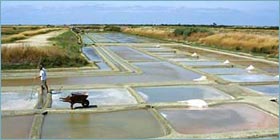
Through her ten small villages, the island reveals multiple aspects of its personality. Each village has its own particular charm: golden sandy beaches for the villages of Les Portes, Saint-Clément des Baleines, La Couarde, Le Bois-Plage and Sainte-Marie-La Noue; reflections of the sky on the salt marshes for the villages of Ars, Loix and Saint-Clément des Baleines; oyster parks at low tide for Rivedoux and Loix; fields of vineyards, market gardens for the villages of Le Bois-Plage and Sainte-Marie-La Noue; tiny fishing ports or marinas for La Flotte, Ars and the largest village of Saint-Martin.
RIVEDOUX-PLAGE
Rivedoux-Plage is the first village you meet on arriving: it allows you to discover that special Ile de Ré light. A big oyster production centre it enjoys magnificent golden sandy beaches.
LA FLOTTE
The village thrived on fishing and trade until the 19th century. There were 8 fine vessels in its port in 1727 and rich merchants had splendid residences built in the village. Today, its port welcomes both fishermen and sailors. The pedestrian streets and its sheltered beach make it a privileged holiday resort all the year round. A favoured market is the daily open-air market at La Flotte, where some of the best restaurants are also found (Le Lavardin, Le Richelieu).
SAINT-MARTIN DE RÉ
A town fortified upon the orders of Vauban, Saint-Martin benefits from a wealthy past. An administrative centre, it is the biggest town on the island. The sheltered port with its harbour is especially picturesque. The ruins of the tower, l'Hôtel de Clerjotte, the numerous private houses and pedestrian alleys of the centre of the town are witnesses of its wealthy past.
ARS-EN-RÉ
In the heart of the salt marshes and the only port on "Le Fier", Ars became prosperous through the salt trade. Today, its harbour welcomes many sailors. The steeple of Ars painted black and white can be seen for leagues around and serves as a marker for vessels navigating in "Le Fier". In the 18th century, Ars had 17 windmills. They have all lost their sails.
LOIX
The village forms a peninsula surrounded by salt marshes and oyster beds. It is more than a haven of peace and quiet. Loix is once more known for its nature reserve. Numerous cycling lanes wander through the marshlands, where a varied fauna lies hidden. "La pointe du Grouin" offers a fine view over one of the largest oyster beds of the island.
SAINT-CLÉMENT DES BALEINES
A former lobster fishing village, Saint-Clément is made of four hamlets: la Tricherie, le Chabot, le Griveau, le Gillieux and le Godinand.
Sheltered by the "Côte Sauvage" coast to the west, the outstretching sandy beach of "la Conche" to the north and the salt marshes to the east, there is the "Phare des Baleines", a lighthouse which rises up 57 m at the far end of the island.
LES PORTES EN RÉ
The last village, at the far end of the island, is surrounded by beaches and fens. If you have never visited Les Portes, you have never really experienced the gentler side of life! In this village at the farthest reaches of the island, far from the madding crowd, you will find the quintessential charm if the Ile de Re - narrow, white-painted and flower-bedecked streets, sand dunes and the forest backing onto a vast expanse of wetland giving onto the Fier d’Ars, one of the largest nature reserves in Europe and a sanctuary for wild birds. The splendid watercourse of "le Fier" offers sheltered moorings. Les Portes en Re is surrounded by the 2 nicest beaches of the island: the very wild La Conche beach close to Le phare des Baleines (the lighthouse) and Trousse-Chemise beach. The wood of "Trousse Chemise" inspired Charles Aznavour's famous song of the same name.
LA COUARDE SUR MER
With its long fine sandy beaches, bordered by pinewoods and tamarisks as far as the bay of Martray, la Couarde is one of the most important resorts on the island. Here, there are many holiday homes and it is very lively in the summer. La Couarde is at the crossroads of many cycle paths. On the north coast, the Goisil channel is very picturesque and unspoilt.
LE BOIS-PLAGE EN RÉ
On the south coast of the isle, this village spread out over several kilometres stands out for its beaches, bordered by sand dunes. It is made of three hamlets: Le Bois, Le Roulant, and Le Morinant. Le Roulant has the only windmill on the island that has kept its sails. Le Bois Plage is surrounded by pines, fields and vineyards. There is a daily open-air market.
SAINTE MARIE DE RÉ - LA NOUE
Between Rivedoux and Le Bois Plage, the village is made up of two smaller villages on the coast: Sainte-Marie and La Noue. Dressed in vines and marsh plantations, it is the most agricultural community on the island, but no less maritime for all that. Excellent shellfish hunting is to be had on the expanse of sand revealed by the retreating tide, and the town’s old fish traps are carefully looked after. The alleys between the white houses with green shutters and hollyhocks, the Chapelle Saint-Sauveur and the Chauveau lighthouse, well-known to fishermen and waders, all add to the old-worldly charm of Sainte-Marie. After a great deal of reconstruction and restoration work, archaeologists sometimes wonder whether anything old is left in the Eglise de Sainte-Marie. However, the spire appears to have kept its XIV th or XV th century look and is a strong point in the landscape panorama of the Ile de Ré. Because of its excellent position, a great number of residents are attracted to the community.
Sainte Marie de Ré is separated into two villages called
Sainte Marie Centre and
La Noue Sainte Marie.
La Noue is the oldest village on the island and its rich soil has contributed much to the area's wine growing. It is a small and charming authentic rural village with a local beach and a spectacular coastline. Even at the height of the season it is quiet and peaceful. In the low season it remains lively thanks to its sedentary population.
In the summer season it has a particularly lively and colourful market: the local producers bring over fresh fruit and vegetables every morning. On the square a fishmonger's and
Vallegeas, the best baker's on the island (restaurants buy their bread from it) offer quality fare all year round. Restaurants, a bar, a tobacconist’s, are also to be found there for everybody's pleasure.
Several times in the summer there is a
Rétais market: costumed locals sell fresh produce from the area. Children are offered hayrides. The Anes culotte (Poitou donkeys in breeches) are never far either.
The beaches are quiet, far from the more crowded resorts of the island. Close to the Plage Saint-Sauveur there is a children's leisure park. The
Plage des Grenettes is ideal for the practice of windsurfing and body-board.
When the tide goes out, the sandy bottoms of the Les Grenettes sluices are good places for fishing for sea bass using natural bait. Do not miss a visit to the medieval fisheries also called
fish locks: they were built in the Middle Ages to feed the armies of the King. They are part of the maritime heritage of Ile de Ré. Their maintenance is passed down from father to son.
To visit them, apply to:
Office du Tourisme de Sainte-Marie de Ré
Place d'Antioche
17410 SAINTE MARIE DE RÉ
Phone: +33 546 302 292 -
Fax: +33 546 300 168
Also to be visited is
La Maison du Magayant, a small local museum installed in the old kiln of La Noue. It explains how the medieval fisheries work and presents the cultural, biological and environmental heritage of the Rétais foreshore or "estran". Temporary exhibitions are available too.
La Maison du Magayant
61, Cours des Jarrières
17410 SAINTE MARIE DE RÉ
Phone/ Fax: +33 546 374 750
Email:
maisondumagayant@wanadoo.fr








